Prokaryot Study guides, Class notes & Summaries
Looking for the best study guides, study notes and summaries about Prokaryot? On this page you'll find 344 study documents about Prokaryot.
Page 2 out of 344 results
Sort by

-
Eukaryotic vs Prokaryotic Cells Questions & Answers
- Exam (elaborations) • 2 pages • 2024
-
- $12.99
- + learn more
Eukaryotic vs Prokaryotic Cells Questions & Answers 1. Prokaryotic cells - ANSWER-Contain plasma membrane, cytoplasm, DNA, and ribosome. Make up single-celled organisms and cells arise from binary fission. Do not have membrane-bound organelles. 2. Eukaryotic cells - ANSWER-Larger than prokaryotic cells. Make up complex organisms. Cells arise by mitosis or meiosis. Have membrane-bound organelles. 3. Plasma membrane - ANSWER-Cell surface made of a phospholipid bilayer. Controls passage of...
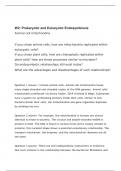
-
BIOL202 Week 2 Discussion; Prokaryotic and Eukaryotic Endosymbiosis
- Other • 2 pages • 2023
-
- $12.99
- + learn more
Week 2: Prokaryotic and Eukaryotic Endosymbiosis Animal cell mitochondria • If you chose animal cells, how are mitochondria replicated within eukaryotic cells? • If you chose plant cells, how are chloroplasts replicated within plant cells? How are these processes similar to microbes? • Do endosymbotic relationships still exist today? • What are the advantages and disadvantages of such relationships?

-
OpenStax Microbiology Test Bank Chapter 4: Prokaryotic Diversity.
- Exam (elaborations) • 18 pages • 2023
- Available in package deal
-
- $11.49
- + learn more
OpenStax Microbiology Test Bank Chapter 4: Prokaryotic Diversity. OpenStax Microbiology Test Bank Chapter 4: Prokaryotic Diversity Page 1 of 17 Chapter 4: Prokaryotic Diversity * = Correct answer Multiple Choice 1. Which is the best example of a population? A. all the microbes living in a particular area B. all the microbes of a particular domain living in a particular area C. all the microbes of a single species living in a particular area* D. all the microbes living within the same ...
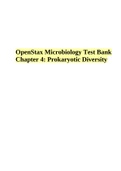
-
OpenStax Microbiology Test Bank Chapter 4: Prokaryotic Diversity
- Exam (elaborations) • 18 pages • 2023
-
- $16.49
- + learn more
OpenStax Microbiology Test Bank Chapter 4: Prokaryotic Diversity. Which term best describes the relationship between pathogenic bacteria and humans? A. amensalism B. commensalism C. parasitism* D. predation Difficulty: Moderate ASM Standard: 23 4. Which of the following is not a class within the phylum Proteobacteria? A. Alphaproteobacteria B. Betaproteobacteria C. Deltaproteobacteria D. Omegaproteobacteria* Difficulty: Easy ASM Standard: N/A 5. Which of the following correctly cha...
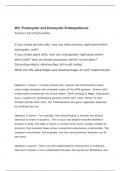
-
BIOL202 Week 2 Discussion; Prokaryotic and Eukaryotic Endosymbiosis
- Other • 2 pages • 2023
- Available in package deal
-
- $19.49
- + learn more
Week 2: Prokaryotic and Eukaryotic Endosymbiosis Animal cell mitochondria • If you chose animal cells, how are mitochondria replicated within eukaryotic cells? • If you chose plant cells, how are chloroplasts replicated within plant cells? How are these processes similar to microbes? • Do endosymbotic relationships still exist today? • What are the advantages and disadvantages of such relationships?
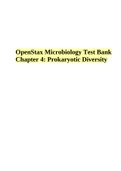
-
OpenStax Microbiology Test Bank Chapter 4: Prokaryotic Diversity 2023
- Exam (elaborations) • 18 pages • 2023
-
- $14.49
- + learn more
OpenStax Microbiology Test Bank Chapter 4: Prokaryotic Diversity 2023. Which is the best example of a population? A. all the microbes living in a particular area B. all the microbes of a particular domain living in a particular area C. all the microbes of a single species living in a particular area* D. all the microbes living within the same host Difficulty: Moderate ASM Standard: 20 2. Microbial ecology is defined as the study of which of the following? A. competitive interactions betw...
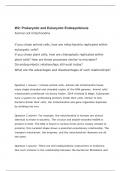
-
BIOL202 Week 2 Discussion Prokaryotic and Eukaryotic Endosymbiosis APU
- Other • 2 pages • 2024
- Available in package deal
-
- $17.99
- + learn more
Week 2:ProkaryoticandEukaryoticEndosymbiosis Animalcellmitochondria • Ifyouchoseanimalcells,howaremitochondriareplicatedwithineukaryoticcells? • Ifyouchoseplantcells,howarechloroplastsreplicatedwithinplantcells?Howaretheseprocessessimilartomicrobes? • Doendosymboticrelationshipsstillexisttoday? • Whataretheadvantagesanddisadvantagesofsuchrelationships?
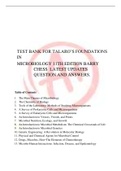
-
Test bank for Talaro’s Foundations in Microbiology 11th Edition By Barry Chess 1. The Main Themes of Microbiology 2. The Chemistry of Biology 3. Tools of the Laboratory: Methods of Studying Microorganisms 4. A Survey of Prokaryotic Cells and Microorganism
- Exam (elaborations) • 45 pages • 2023
-
Available in package deal
-
- $14.49
- + learn more
Test bank for Talaro’s Foundations in Microbiology 11th Edition By Barry Chess 1. The Main Themes of Microbiology 2. The Chemistry of Biology 3. Tools of the Laboratory: Methods of Studying Microorganisms 4. A Survey of Prokaryotic Cells and Microorganisms 5. A Survey of Eukaryotic Cells and Microorganisms 6. An Introduction to Viruses, Viroids, and Prions 7. Microbial Nutrition, Ecology, and Growth 8. An Introduction to Microbial Metabolism: The Chemical Crossroads of Life 9. An Introduction...

-
Eukaryotic vs Prokaryotic Cells Questions & Answers
- Exam (elaborations) • 2 pages • 2024
-
- $10.49
- + learn more
Eukaryotic vs Prokaryotic Cells Questions & Answers 1. Prokaryotic cells - ANSWER-Contain plasma membrane, cytoplasm, DNA, and ribosome. Make up single-celled organisms and cells arise from binary fission. Do not have membrane-bound organelles. 2. Eukaryotic cells - ANSWER-Larger than prokaryotic cells. Make up complex organisms. Cells arise by mitosis or meiosis. Have membrane-bound organelles. 3. Plasma membrane - ANSWER-Cell surface made of a phospholipid bilayer. Controls passage of...
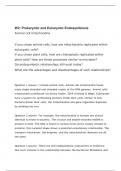
-
BIOL202 Week 2 Discussion; Prokaryotic and Eukaryotic Endosymbiosis
- Other • 2 pages • 2023
-
- $18.49
- + learn more
Week 2: Prokaryotic and Eukaryotic Endosymbiosis Animal cell mitochondria • If you chose animal cells, how are mitochondria replicated within eukaryotic cells? • If you chose plant cells, how are chloroplasts replicated within plant cells? How are these processes similar to microbes? • Do endosymbotic relationships still exist today? • What are the advantages and disadvantages of such relationships?

That summary you just bought made someone very happy. Also get paid weekly? Sell your study resources on Stuvia! Discover all about earning on Stuvia


